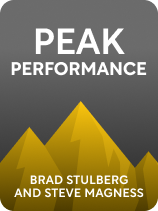

This article is an excerpt from the Shortform book guide to "Peak Performance" by Brad Stulberg and Steve Magness. Shortform has the world's best summaries and analyses of books you should be reading.
Like this article? Sign up for a free trial here.
What’s a pre-performance routine? How can you craft a routine that guarantees mental and physical benefits?
According to Brad Stulberg and Steve Magness, an essential part of optimal performance in any domain is a consistent pre-performance routine. To craft your own routine, they recommend cultivating a positive mood, incorporating your environment into your routine, and personalizing your routine.
Continue reading to get a better understanding of why you need a pre-performance routine.
Make a Positive Mood Part of Your Routine
Stulberg and Magness contend that putting yourself in a positive mood as part of your pre-performance routine is beneficial for both intellectual and athletic pursuits. Regarding intellectual work, they cite a study that assessed participants’ moods and then subjected the participants to creative problem-solving tests—participants whose moods were positive before the test consistently outperformed those whose moods were negative. Regarding athletic work, Stulberg and Magness point to a study of elite cyclists in which experimenters briefly flashed a happy or sad face to the cyclists during an intense workout; they found that those who saw the happy face performed significantly better than those who saw the sad face.
(Shortform note: Even if you aren’t actually experiencing a positive mood, simply feigning a positive mood can have beneficial effects. In particular, sports scientists found that runners who force themselves to smile during runs process oxygen more efficiently and decrease their perceived exertion levels compared to those who are frowning. For this reason, two-time Olympic marathon gold medalist Eliud Kipchoge is known for smiling throughout his races, even when he’s in severe pain.)
Stulberg and Magness suggest that there’s no foolproof path to putting yourself in a positive mood. However, they do recommend that you avoid things that you know will put you in a negative mood, since such factors will make it difficult for you to optimize your routine.
(Shortform note: Simply avoiding negative mood triggers may not be enough to change your mood—experts emphasize that cultivating a positive mood also requires taking affirmative steps to become more positive. For example, they recommend consciously appreciating little joys in your daily life, like the scent of your coffee or a crisp morning breeze. Additionally, they suggest celebrating others’ accomplishments and victories, since that opens up a new source of positivity beyond your own accomplishments.)
Incorporate Your Environment Into Your Routine
In addition to cultivating a positive mood, Stulberg and Magness advise intentionally creating an environment that’s conducive to success, since insights from ecological psychology show that our environment conditions our behavior. They point out, for instance, that merely seeing a photo of a chair stimulates the area of our brain associated with sitting in a chair. More generally, Stulberg and Magness contend that our brains can associate our working environments with high performance, priming us to succeed. For example, if a writer always writes in the same leather chair with a coffee on the desk, the very sight of that particular chair and coffee will prepare their brain for the act of writing.
(Shortform note: For remote workers who have greater flexibility in structuring their work environment, experts offer a wide array of strategies for crafting an effective one. For instance, they recommend choosing a workplace with significant natural light, since natural light can increase your energy levels and productivity. Further, they suggest including small plants at your workplace to lift your mood, and reducing additional clutter on your desk to minimize distractions and make yourself more efficient.)
Personalize Your Routine
Finally, Stulberg and Magness acknowledge that no two routines are identical, so you have to develop your ideal routine. For instance, LeBron James is known for reading a book in the locker room before playoff games to calm his nerves, while Stephen Curry performs the same 20-minute on-court workout before every basketball game. So, according to Stulberg and Magness, as long as your routine involves a positive mood and an intentionally constructed environment, you’re free to craft the routine that suits you best.
(Shortform note: Although Stulberg and Magness emphasize that routines must be personalized to each individual, experts point out that effective routines often have a lot in common. For example, healthy routines involve scheduled breaks to give you time to recuperate and incorporate concrete goals that you seek to meet each day. Further, they emphasize that strong routines are often centered around solid sleeping habits and a healthy breakfast to fuel your workday.)

———End of Preview———
Like what you just read? Read the rest of the world's best book summary and analysis of Brad Stulberg and Steve Magness's "Peak Performance" at Shortform.
Here's what you'll find in our full Peak Performance summary:
- That the quest for excellence leaves us suffering from exhaustion and burnout
- Why cycles of stress and rest are necessary for sustainable elite performance
- How to develop a consistent routine and structure your time






